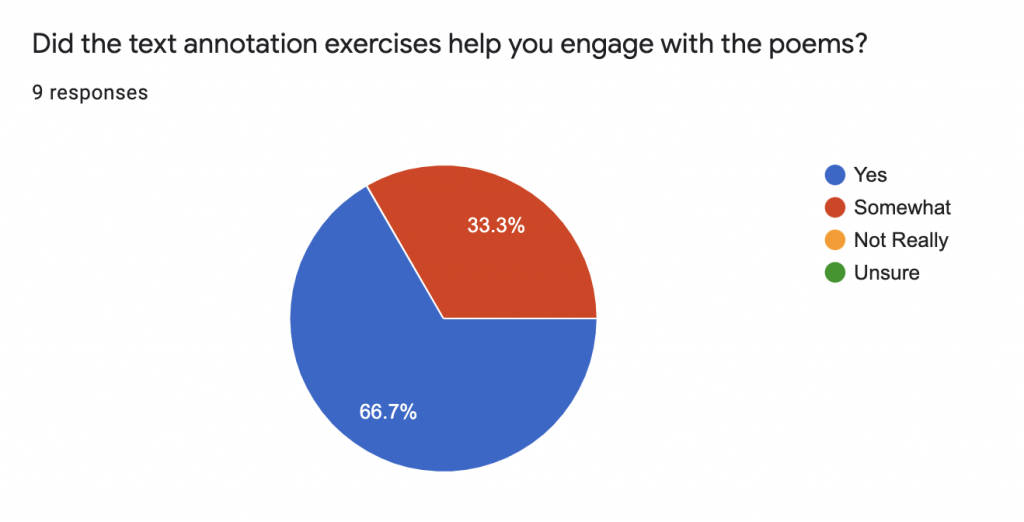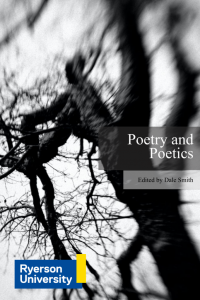Case Studies from the Public Domain
Social Annotation of Public Domain Poetry
Book Used: Poetry and Poetics
Dr. Dale Smith, Associate Professor of English at Ryerson University, created an open assignment that asked students to use the Hypothes.is web annotation software to annotate public domain poetry in an open anthology created for his course using Pressbooks. Annotations created for this assignment are publicly available and can be viewed alongside the book on the web. They were used as a basis for class discussion and later fed into a graded group assignment.
About the Course
ENG560 – Poetry and Poetics is an upper year undergraduate course taken primarily by English students; however it may also be taken as an elective course by students in other programmes. The course considers the poetics, politics and social practices that produce new forms of creative responses to poetry.
Format of the Course
The course, which took place in the fall of 2021, was an in-person three hour lecture held once a week. The in-class course time was broken down as follows:
First hour – Lecture by the professor
Second hour – Group work by students with the poems and other assignments; students would read the poems to one another and work on annotating poems using Hypothes.is
Third hour – Discussion with the professor
The Annotation Assignment
Because this was the first time the instructor had used Hypothes.is, the assignment was somewhat fluid. The annotation component of the assignment took place in the second hour of the class each week when students worked in groups with assigned poems. These annotations then fed into a larger group assignment. All annotations were made in the public layer of Hypothes.is (visible to anyone on the web). Students were given the option of creating their Hypothes.is account using their own name or using an alias (which was shared with the instructor for marking purposes).
The objectives of the annotation exercise and assignment were to help the students critically engage with poetic texts and to produce conversation around the poems. This editorial function introduced them to methods of critical commentary and citation while also drawing them closer to the poems. Students chose to annotate poems that they found to be compelling and in need of editorial commentary and citation. The annotations allowed the students to establish the context of the poems, to scrutinize their forms and vocabulary, and to expand upon historical, literary, and cultural references contained within the poems. Because both the course reader, Poetry and Poetics, and the annotations are publicly available on the web, the students’ work will contribute to the discourse around the poems.
Grading of Assignment
The individual annotations were not graded, although the instructor did check to ensure that the students had made the required number of annotations. The group project based on the annotations was worth 20% of the final mark for the course.
Use of Pressbooks as a Platform for the Book
Pressbooks was used as the platform for publishing the book on the web and for creating pdf and epub versions that could be read offline. The instructor provided a list of readings to the Library publishing staff who assessed the copyright status of the poems to determine how the poem would be represented in the anthology.
The texts fell into three broad copyright categories: public domain texts, copyrighted texts available on the web and copyrighted texts not available digitally. Due to copyright restrictions only public domain texts could be added directly to the book. Most of the texts fell into this category. Copyrighted texts that were available from specialized websites, were added to the textbook as links and copyrighted materials not available in digital form were referenced with instructions on how to acquire the texts.
Although the majority of the texts were in the public domain and already readily accessible on the web, there was a distinct advantage to having them collated for the course. Students appreciated having the resources compiled in this way and not having to navigate a large number of disparate websites.
Comments from students about the anthology included:
“even though im[sic] sure most of the poems were easily found online it was nice to have them compiled in this manner”
“It was something I appreciated since I was able to access it quickly and did not have to constantly go through login pages.”
The instructor also found that the Pressbooks platform worked well for his purposes. The book was easy to navigate and it was arranged to follow the weekly structure of the course.
Because Hyptothes.is is integrated within Pressbooks, all that the students needed to do to start annotating the text was to set up a free Hypothes.is account. Downloading a browser extension, necessary for annotating most content on the web, is not required for working with Hypothes.is in Pressbooks.
Student Feedback on Annotation Assignment and Textbook
At the end of the semester, students in the course were asked to complete a voluntary, anonymous survey about the textbook and the annotation assignment. Nine of the thirty-six students completed this survey. Overall students were appreciative of the textbook and the assignment and all of the students were happy to have the required textbook available at no cost to them.
The survey asked several questions about the text and the assignment. When asked “Did the text annotation exercises help you engage with the poems?”, six students responded “yes” and three responded “somewhat”.

A follow-up questions asked for comments about how the text annotation increased engagement. The students indicated that it helped them to be more organized, enabled them to learn from their peers and encouraged research about the poems.
The students were also asked if the annotation exercise helped increase interaction opportunities with their peers. Again six students answered”Yes” and three answered “Somewhat”. The ability to reply to other students annotations was noted as one way of increasing interactions with others in the course.
When asked to compare the Hypothes.is annotation exercise to discussion board assignments, one student noted that annotation was a “fresh idea that I enjoyed over discussion posts” and another that discussion posts are “more monotonous and tedious”.
Another student commented that annotations worked better for the short comments and notes that were being added to the poems. They felt that they were more likely to respond to other students annotations than to discussion board assignment posts. The Hypothes.is annotations were seen to be more interactive and encouraged peer-to-peer learning.
The final question in the survey encouraged students to submit general comments. One suggestion indicated a preference for using a private, class group rather than annotating publicly. Private groups are available with Hypothesis, and students can still benefit from this activity; however, no one outside the class is able to see the annotations. In this case the professor preferred to have the students annotate publicly he wanted the students’ annotations to become part of the body of knowledge generated around the poems.
Instructor Assessment of Assignment
Overall the instructor was happy with the results of the assignment and student interaction in the class. He found that the students were very engaged with the texts and that class attendance was good; the students particularly enjoyed the second hour of the class where they worked on the annotations and read the poems to one another. This format allowed the students to get close to the poems and generated conversation around them.
The instructor indicated that he would consider doing another similar assignment but, based on the experience with this assignment, he would have the students work exclusively in groups and he would provide more structure to the assignment.


